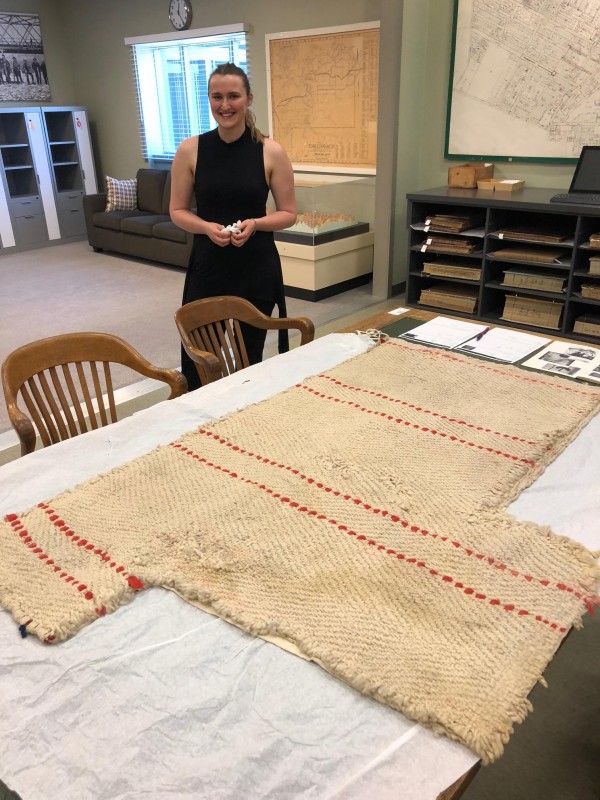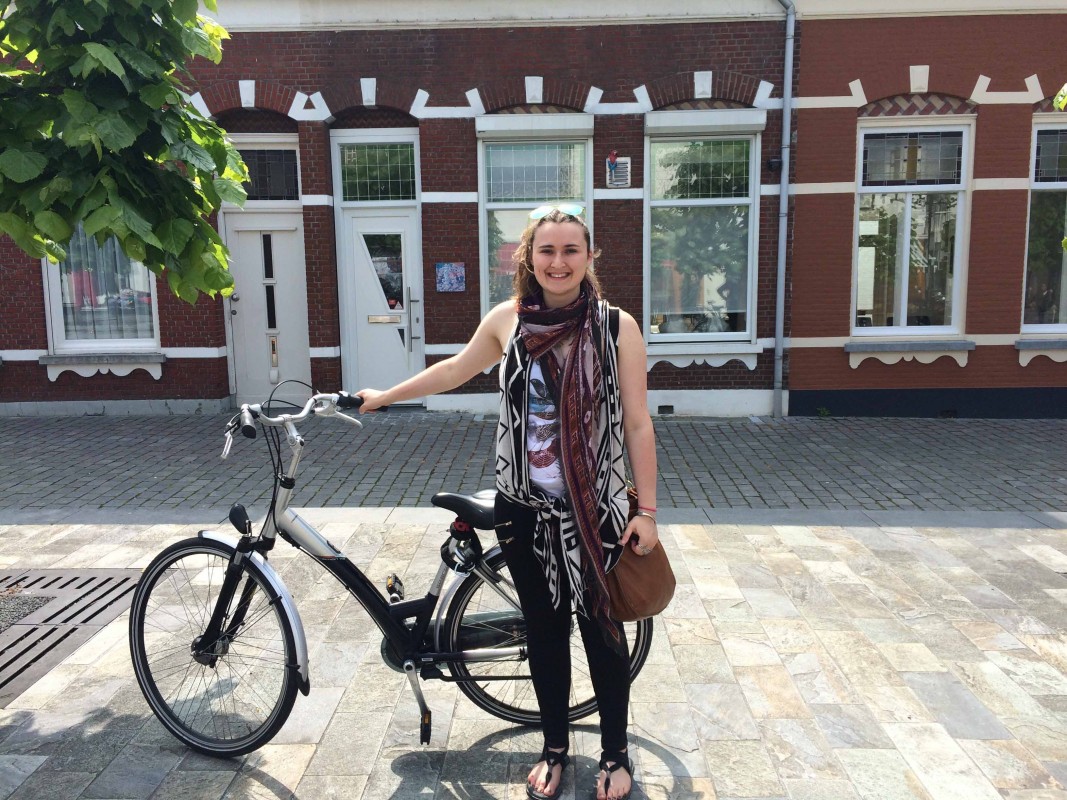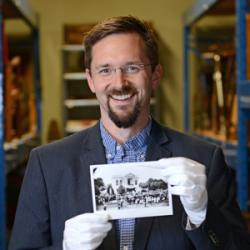In late June 2018, we welcomed a new Curator to the staff of the Chilliwack Museum and Archives.

Curator Anna Irwin with a woven Salish blanket from approximately 1830.
I am delighted that Anna Irwin, who takes on this key role, has long called Chilliwack home. Anna takes over from Jane Lemke, who accepted a new position with another great B.C. Museum, and from Adrienne Rempel, who served as Curator this past year. An award-winning graduate of the University of the Fraser Valley’s History Program, Anna has also completed the University of Victoria’s highly regarded Professional Specialization Certificate in Collections Management, with a focus in Curatorial work. She is no stranger to the Museum and Archives, as she has worked part-time with us for the past few years. Until recently, Anna served as Program Manager at the Trethewey House Historic Site in Abbotsford. Anna brings creativity, knowledge, and energy to the curatorial role. Executive Director Matthew Francis recently had the opportunity to speak with Anna about her new work.
——————————————————————————————————————–
Q: Anna – thanks for taking the time to speak with me, and to share about yourself and your work. What are some of the things you appreciate about Chilliwack?
There are so many things to love about Chilliwack but one of my favourite things about Chilliwack are the local mountains. While I have lived in Chilliwack (almost) my whole life, I did not realize how much I took our local mountains that surround us in the Fraser Valley for granted until I left to briefly study French at l’Université de Sherbrooke during my undergraduate degree. While the experience was fantastic (and the food and people were absolutely delightful), one of the things I noticed was that I became nostalgic over our local mountains.
The mountains in the Fraser Valley, such as Mount Cheam, are much larger and are found much more frequently than mountains in the Eastern Townships. When I looked out onto the Sherbrooke horizon one day from the window, it felt empty and incomplete. At the time, I couldn’t quite place why I felt the way that I did, but upon returning home a few weeks after looking out the window, the answer became quickly apparent. The mountains are a source of familiarity and comfort that define “home”. I feel so lucky to have the opportunity to live and work in a place where they are so readily seen from almost any place in the City. We truly live in one of the most beautiful spots in the world.
Q: What initially interested you in working in Museums?
My interest in museums originally spurred from two things: a sharp interest in learning about the local community and a love of working with people. In museums, these two things often work well in tandem – one of my absolute favourite things to do is to either talk to visitors about what they remember about Chilliwack from decades past or to delve into the local history literature and archival material at the museum to learn about obscure or quirky stories from our past.
Stories are the lifeblood of any museum and object collection. Without the story about why an object is significant and related to a community (otherwise known as provenance), an object is just that: an object. The stories and people that are associated with artifacts can be just as – if not more, in certain instances – important than the artefact itself. They provide context where needed and allow us a window into the past.
For example, a cardboard checkerboard with tidemarks without additional context remains a cardboard checkerboard with tidemarks. While it may, in certain instances, be possible to learn about the year the board was made and where it was produced, the stories pertaining to the checkerboard do not exist and, in some instances, have been lost. Stories allow us to know who used the checkerboard, to learn what caused the tidemarks, to learn where the checkerboard was used and from all of that, allow us to see how the checkerboard fits into the larger swath of Chilliwack’s history. Research, interviewing and having discussions with visitors and donors are all crucial in helping learn more about both the museum’s collection and Chilliwack’s history as a whole.
Q: Some people may wonder. What is it exactly that curators do? Sometimes it may feel a bit mysterious. Can you help to explain what it is that curators do?
Curators work primarily to preserve and share tangible history.
While this may sound fairly succinct and straightforward, the position has many broad tasks, including cataloguing and housing new donations to the museum’s artefact collection, assessing integrated pest management strategies and environmental conditions of both the museum and the archives facilities, assisting visitors at the archives, researching upcoming exhibit themes, connecting with community groups for exhibit research and consultation, designing graphics and exhibit labels, and more!
While most of these tasks relate to collections management or exhibition development and the extent to which each are pursued on a day-to-day basis, all play an important role in ensuring Chilliwack’s history can be passed on to and enjoyed by the public and future generations.
Q: Anna – what is your favourite part about being a curator?
While I truly love the “Jack of all trades” nature of being a curator (to quote one of my predecessors, Jane Lemke), my favourite part of being a curator is working with the community to develop exhibitions. As one of my mentors used to tell me “it takes a village to raise an exhibit” and this is a concept that I wholly live by – exhibitions are concepts built with the help of the community and offer a forum for local voices, both historic and contemporary, to come alive, come together and be heard through archival and object collections, interviews, and active consultation and discussions with local groups and community members.
While a significant amount of research and preparation for upcoming exhibits is conducted “behind the scenes” by staff members, these local voices truly make the exhibit a reflection of its community and allow visitors – particularly those from Chilliwack – to feel an increased sense of ownership and participation in the exhibition development process. Continuing to develop this relationship while bridging the past and present in the museum’s public spaces is something I am very much looking forward to, as we gear up for our new exhibit centered on music, set to open in early 2019.
Q: So what are you looking forward to the most in your new job as Curator at the Chilliwack Museum?
I may have accidentally answered this question in the previous question, but in addition to working with the public during the exhibit development process, I am very much looking forward to working with the collection. While I studied collections management at the University of Victoria and have worked with artefact collections in the past, most recently I have been working in programming as the Programs Officer at Trethewey House Heritage Site, leading educational programs and running the volunteer and membership programs (amongst other things!). Having the opportunity to shift gears and actively work to preserve Chilliwack’s extensive and rich artefact collection (especially in my hometown!) is a true honour.
Q: What’s one fun fact about you that people may not know?
For the past few years, I have been working on watching or collecting as many covers of Nirvana’s “Smells Like Teen Spirit” as I can find. It’s a slightly obscure and very specific hobby.

Anna Irwin, new Curator at the Chilliwack Museum and Archives
That’s amazing! I’m even more excited for our upcoming music exhibition now! Thank you so much, Anna, for taking the time to talk. We wish you all the best in your work as Curator at the Chilliwack Museum and Archives.
If community members are interested in speaking further with Anna about Chilliwack’s history or about historic objects, you can contact her at 604-795-5210 ext. 105 or by email at anna@chilliwackmuseum.ca.


Comments are closed.